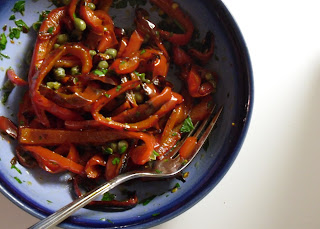In case you missed it on the national news, we had a veritable blizzard this week in Boulder. In snowed for almost 48 hours without stopping. I kept a close eye on what was going on outside from my balcony, and my total snow fall estimate is close to three feet, and I’m pretty sure the media agrees with me. Somehow, by the grace of the gods, this resulted in an actual snow day. I figured that, at 25 years old, I had already exceeded my snow day quota, but I was wrong. Comfort food cooking was in order to keep myself warm and cozy. Plus, my unexpected day off necessitated a celebration. Of course, my first inclination was some sort of creamy pasta, but I make pasta all the time, and I felt that a blizzard deserved something a little less pedestrian. Well, I mean pedestrian in terms of what frequents my kitchen, because what I chose happens to be one of the most common American dishes of all: meatloaf. I decided to prepare a genuine blue plate special: meat, potatoes, and a vegetable. If only I had one of those plates with dividers…
Turkey Meatloaf
1-tablespoon olive oil, plus a drizzle for the bottom of the baking dish
½ onion, diced finely
½ red bell pepper, diced finely
¼ cup chopped flat leaf parsley
½ cup Italian style breadcrumbs
2 eggs, lightly beaten
2 tablespoons milk
¼ finely grated Parmesan cheese
1 lb. ground turkey (I used dark meat, more fat=more flavor)
3 big pinches kosher salt
About 25 grinds of black pepper
8 oz. can of tomato sauce
§ Preheat oven to 400 degrees (probably 375 would do if you’re at sea level).
§ Sauté onion and red pepper in the olive oil in a skillet over medium-high heat for about 5 minutes, until the vegetables start to soften. Set aside to cool
§ Mix together parsley, breadcrumbs, cheese, eggs, milk, salt, pepper, and cooled vegetables. Add turkey and mix gently, so all the ingredients are evenly distributed, but without over-working the meat.
§ Transfer to an oiled baking sheet or casserole dish and shape into an oval loaf. Pour tomato sauce over the top. Bake in the oven for an hour (or an hour and 15 minutes if you have salmonella paranoia like me. If you have an instant read thermometer, the temperature should be 165 degrees in the center. Otherwise cut into it to make sure it’s not pink).
Comments: I went with turkey meatloaf, and gave it an Italian flare. It tasted like a giant oven-roasted meatball (yum!) with a tomato sauce glaze. I'm not sure if the milk was necessary. It most likely would have been moist enough without it, but the milk was definitely not detrimental. For potatoes, I made my family’s favorite twice-bake potato casserole, which I wrote about in my Rosh Hashanah post. It is made with the flesh of baked potatoes (leaving me with a potato skin snack) mixed with sour cream, butter, garlic salt, Lawry’s seasoning salt, and parmesan, and then baked again. It’s not exactly the culinary masterpiece I would want to serve James Beard, for example (assuming time travel is possible), but it is exactly what I wanted to eat while watching the wooden fence surrounding my apartment building shrink as the snow piled up. On second thought, James would probably love those potatoes, and so would you. Steamed broccoli rounded out this decadent meal. Dinner is healthy when there’s something green on the plate, right?
If you make extra broccoli, the next day (or later that night if you get hungry), you can stuff it into the leftover potato skins. Reheat them in the microwave, and top them with a little cheese. Assuming you don’t go overboard with the cheese (and I promise I didn’t), this actually is healthy. Speaking of leftovers, you haven’t truly lived until you’ve eaten a meatloaf sandwich. You can brown up a slice in a pan or just have a sandwich cold; it’s wonderful either way. It’s a lunchtime decision you won’t soon regret.













